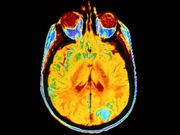

They’ve long been associated with Alzheimer’s disease, and now new research in animals suggests that protein plaques might slow the brain’s blood flow, as well.
Buildup of the amyloid beta protein clumps could harm the brain in multiple ways, according to a team from the University of Alabama at Birmingham.
“We have increasingly become aware that the disruption of blood flow in the brain can increase the risk of Alzheimer’s disease,” lead researcher Dr. Erik Roberson, an associate professor of neurology, said in a university news release.
He explained that scientists have long known that protein plaques known as “vascular amyloid” can build up around blood vessels, just as they do in brain tissue.
However, “we did not fully understand its effects,” Roberson said. Now, high-tech imaging “allows us to visualize how it affects the function of those vessels,” he said.
As Roberson explained, brain cells called neurons require extra glucose — brought in by the bloodstream — for energy whenever there’s a boost in brain activity. Neurons “call” for more glucose via another cell called an astrocyte. Astrocytes have tiny projections called endfeet that attach to blood vessels and tell the vessel to expand when more blood is needed.
Roberson’s team wondered if a buildup of amyloid plaque around vessels might “crowd out” the endfeet, so neural messages for more blood flow wouldn’t get through.
Using high-tech scans, the researchers “were able to determine that, yes, vascular amyloid did push the astrocytic endfeet away and interfered with normal regulation of blood vessels,” Roberson said.
This seemed confirmed in an animal model of Alzheimer’s disease, said another university researcher, Ian Kimbrough. “In locations where no vascular amyloid was present, we saw a very dramatic and robust vessel response; however, on blood vessels that were surrounded by plaque, we saw a much diminished response,” said Kimbrough, a graduate research assistant in neurobiology.
Roberson and Kimbrough explained that as the plaque buildup worsens, the vascular amyloid encircles blood vessels. Then links form between the vessels, creating a rigid “exoskeleton” that hampers the vessels’ ability to dilate or contract.
“The vessel has to be able to expand and contract, to dilate and constrict, if it’s going to regulate blood flow,” Roberson said. “If they have become rigid like a pipe, instead of having a flexible wall that can go back and forth, then they cannot do their job of regulating blood flow to the brain properly.”
This research is still in its early stages, and experts note that there’s never a guarantee that laboratory or animal studies can be replicated in humans. The study was funded by the U.S. National Institutes of Health and published Nov. 23 in the journal Brain.
More information
The U.S. National Institute on Aging has more about Alzheimer’s disease.
Source: HealthDay
Copyright © 2025 HealthDay. All rights reserved.

Leave a Reply